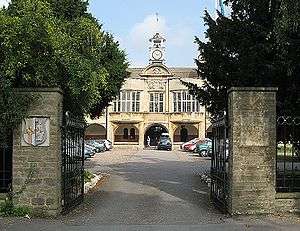Leonard Stokes
Leonard Aloysius Scott Stokes (1858 – 25 December 1925) was an English architect.

Leonard Stokes was born in Southport (then in Lancashire) in 1858 the son of Scott Nasmyth Stokes a school inspector. He trained in London and travelled in Germany and Italy. Most of his designs were for Roman Catholic buildings, including churches, convents and schools. His first work was Sacred Heart Church, Exeter.[1] He also designed the Church of St Clare, Liverpool, which was completed in 1890. He also designed country houses and around 20 telephone exchanges. In 1919 he was awarded the Gold Medal of the Royal Institute of British Architects, having served as their president from 1910 to 1912. Sir Albert Edward Richardson, who later became president of the Royal Society, trained in his offices.
His brother Wilfred Stokes was an engineer and inventor. His nephew Richard Stokes was a Labour MP and minister.
He died in 1925 in Chelsea, London[2] and is buried at St Mary Magdalen Roman Catholic Church, Mortlake.[3]
References
- "Exeter - Sacred Heart / Diocese of Plymouth / Dioceses / Home / Taking Stock - Taking Stock". taking-stock.org.uk. Retrieved 31 December 2015.
- Howell, Peter (2010) [2004], "Stokes, Leonard Aloysius Scott (1858–1925)", Oxford Dictionary of National Biography, Oxford University Press, retrieved 18 August 2013 ((subscription or UK public library membership required))
- "St Mary Magdalen's Roman Catholic Churchyard". London Gardens Online. London Parks and Gardens Trust. Retrieved 10 September 2019.
Further reading
- Adolf K. Placzek, ed. (1982). "Leonard Stokes". Macmillan encyclopedia of architects. 4. Free Press. ISBN 978-0-02-925000-6.
- Gray, Alexander Stuart; Breach, Jean; Breach, Nicholas (1986). "Leonard Stokes". Edwardian architecture: a biographical dictionary. University of Iowa Press. ISBN 978-0-87745-136-5.
- Drysdale, George (1927). "The Work of Leonard Stokes". Journal of the Royal Institute of British Architects. 34 (5): 163–177.CS1 maint: ref=harv (link) (also published in Architecture in 1926)